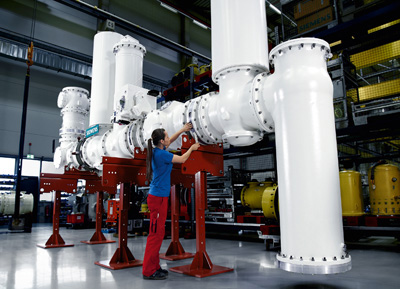Siemens presents first gas-insulated 320-kV switchgear for direct current transmission

In a typical configuration, the DC switchgear consists of the following main components: disconnectors, grounding switches, current and voltage measuring systems, cable and connection modules, and surge voltage protectors.
At the Cigré conference in Paris, Siemens today presented the first compact gas-insulated switchgear (GIS) for high-voltage direct current applications. Within the framework of the energy transition, high-voltage direct current (HVDC) transmission is gaining in significance as it allows low-loss transmission of large amounts of electricity over long distances.
The new 320-kilovolt (kV) gas-insulated switchgear uses up to 95 percent less space compared to previous air-insulated units. When used on an offshore platform, the platform size can thus be decreased by approximately 10 percent.
The efficient HVDC transmission technology is necessary to bring wind power generated in the North Sea to load centers in southern Germany, for example. For this, 155 kV of alternating current (AC) from wind power is converted on a converter platform into 320 kV of low-loss direct current (DC) and then transmitted to land via submarine cables.
When transmitting electricity, the general rule is that the higher the voltage, the less power lost. Once on land, a converter station converts the direct current back into alternating current for further distribution.
The direct current switchgear that is part of the converter station currently uses air-insulated technology and thus requires a large amount of space. Because of air's relatively low insulating capability, the individual components can only be installed with a large amount of space between them and also between them and the earth potential.
The air-insulated DC switchgear that has been used on Siemens' converter platforms until now requires about 4,000 cubic meters of space, thereby requiring halls that are from two to ten meters high. However, space is a decisive cost factor both out at sea as well as in urban population centers. The innovative, compact DC CS (Direct Current Compact Switchgear) has the same capacity but needs only 200 cubic meters, thereby allowing space savings of up to 95 percent.
“With the 320-kV DC CS switchgear's market readiness, we have laid a cornerstone for the development of a completely new portfolio for efficient power transmission. Space-saving direct-current transmission solutions will continue to grow in significance in the future,” explained Denis Imamovic, head of development for gas-insulated direct current transmission systems at Siemens. “We believe that the DC CS switchgear will establish itself as the standard for offshore converter platforms and thereby play a major role in decreasing costs for HVDC transmission grid connections.”
In addition to the small size, the newly developed switchgear has other advantages. Its module-based design makes the DC CS especially flexible and simple to set up, and enables the use of cost-efficient shipping and transportation methods. Because all current-carrying parts are fully encapsulated, the system can also be reliably installed under demanding environmental conditions, such as on the high seas or near the coast, and it does not necessarily have to be housed in a building. Furthermore, the compact switchgear offers maximum reliability and low maintenance costs. The DC CS systems are manufactured in Siemens' Berlin switchgear production plant.
While gas-insulated, three-phase current switchgear has been part of Siemens' portfolio for decades, there had not been a corresponding gas-insulated technology for direct current applications to date. Since controlling an electric field under direct current is very complex, it had not been possible until now to build gas-insulated, compact DC switchgear for HVDC transmission applications. The development of a new isolator, which can permanently withstand the demands of high-voltage direct currents, made it possible to develop the first DC GIS switchgear. A pilot station based on 320-kV direct-current components that simulates the connection of an offshore wind farm to the grid is currently being run through a long-term test.
DC CS systems and the associated service are part of Siemens' Environmental Portfolio. Around 43 percent of its total revenue stems from green products and solutions. That makes Siemens one of the world's leading providers of eco-friendly technology.
For further information on Siemens@CIGRE, please see: www.energy.siemens.com/hq/en/energy-topics/tradeshows/cigre.htm
The Siemens Energy Sector is the world's leading supplier of a broad spectrum of products, services and solutions for power generation in thermal power plants and using renewables, power transmission in grids and for the extraction, processing and transport of oil and gas. In fiscal 2013 (ended September 30), the Energy Sector had revenues of EUR26.6 billion and received new orders totaling approximately EUR28.8 billion and posted a profit of approximately EUR2 billion. On September 30, 2013, the Energy Sector had a work force of approximately 83,500. Further information is available at: http://www.siemens.com/energy
Reference Number: EPT201408064e
Media Contact
All latest news from the category: Trade Fair News
Newest articles

Parallel Paths: Understanding Malaria Resistance in Chimpanzees and Humans
The closest relatives of humans adapt genetically to habitats and infections Survival of the Fittest: Genetic Adaptations Uncovered in Chimpanzees Görlitz, 10.01.2025. Chimpanzees have genetic adaptations that help them survive…

You are What You Eat—Stanford Study Links Fiber to Anti-Cancer Gene Modulation
The Fiber Gap: A Growing Concern in American Diets Fiber is well known to be an important part of a healthy diet, yet less than 10% of Americans eat the minimum recommended…

Trust Your Gut—RNA-Protein Discovery for Better Immunity
HIRI researchers uncover control mechanisms of polysaccharide utilization in Bacteroides thetaiotaomicron. Researchers at the Helmholtz Institute for RNA-based Infection Research (HIRI) and the Julius-Maximilians-Universität (JMU) in Würzburg have identified a…



